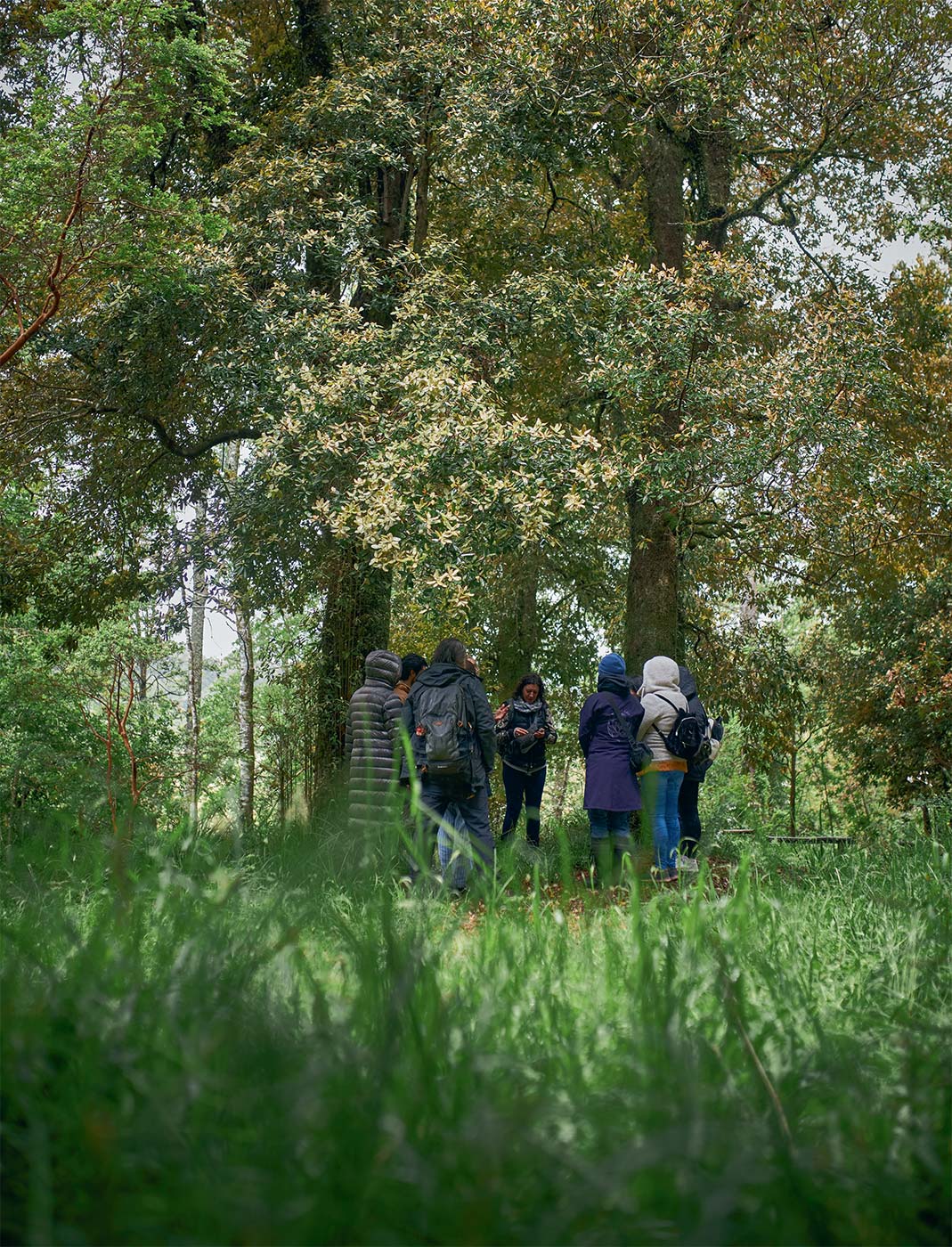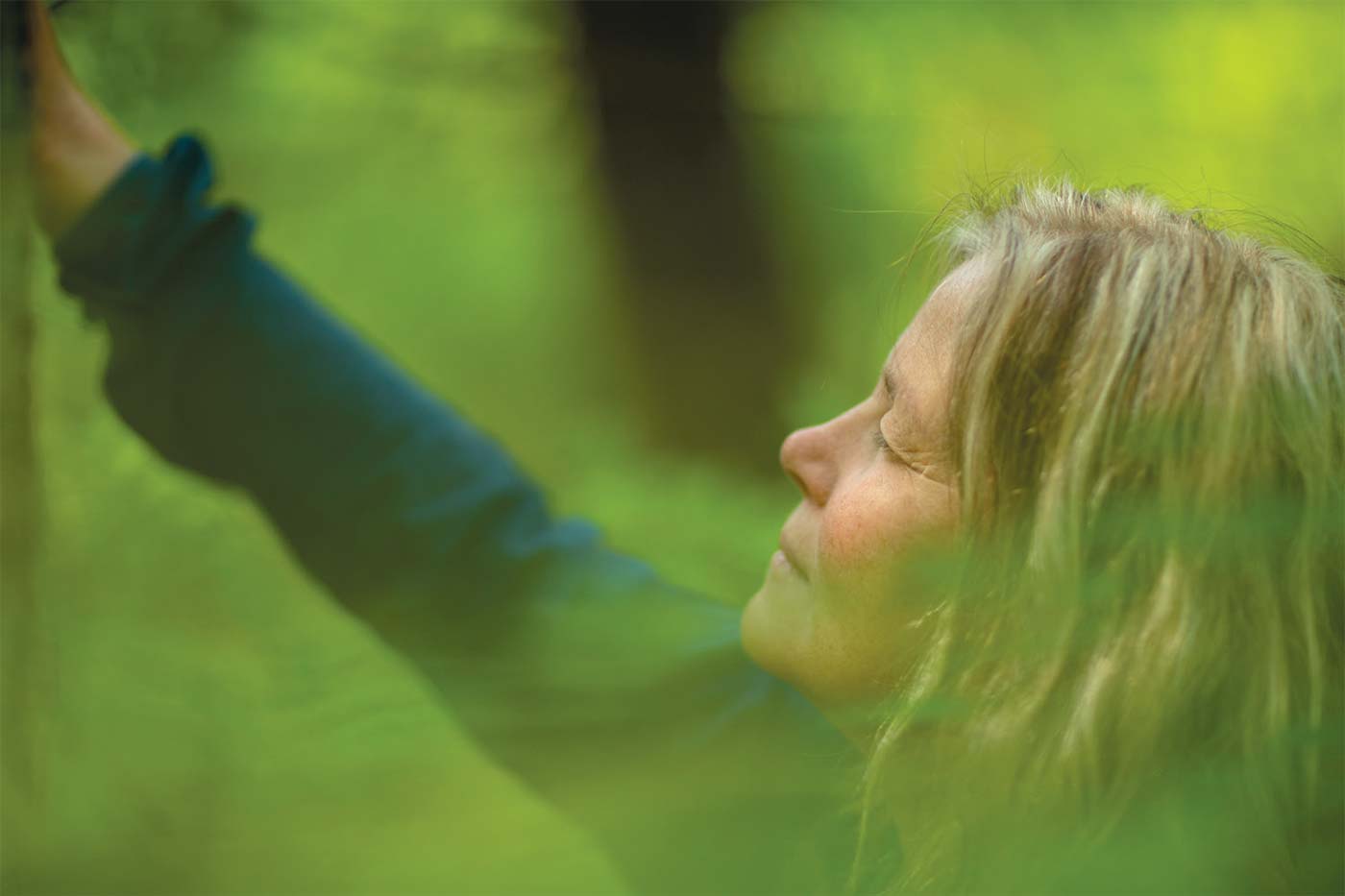Naked Wilderness

Training session in the forest. (Forest Therapy Hub)
What do you hear? What do you see? What do you feel? It’s an all-senses experience rather than a walk-and-talk experience.
Envision yourself among the woodsy scents of evergreens and dewy earth, listening to the sounds under your feet, deeply inhaling unblemished air in a meditative state. There is a term for this newly popular mindfulness practice, which helps individuals connect to themselves while reunifying with Mother Nature: forest bathing.
Since it emerged in the 1980s in Japan, shinrin-yoku (“forest bathing” or “taking in the forest atmosphere”) encourages communing with wilderness—in particular, with trees. Simply, it’s the practice of slowly walking among the branches, using all the senses to become present with the woods: touching bark, listening to birdsongs, savoring the fragrance of flowers. Today, forest bathing has spread across continents. Global practitioners teach individuals, couples and corporate groups how to “bathe” in the forest.
While many may argue that the therapeutic practice has been appreciated since the dawn of time, it was given a name in 2018 by Dr. Qing Li, an associate professor at Tokyo’s Nippon Medical School and a fellow at Stanford University School of Medicine. His book Forest Bathing: How Trees Can Help You Find Health and Happiness (Penguin Life), has been published in over 20 languages and has become the definitive guide.
But for someone like me, who has always been a casual “seeker” looking for answers from the universe through yoga, transcendental meditation and other spiritual practices, what makes forest bathing different than a mere walk in the park or even a hike?
To assist me in answering this question, I reach out to Forest Therapy Hub, an international group of trained therapeutic professionals who use forest bathing as a tool to connect people to the planet.
Executive Director Alex Gesse oversees the instruction of forest bathing and forest therapy. We discuss my question over a video call. Charming with his gray hair illuminated from a window behind him, there is an unintended saintly glow. “I like your approach to forest bathing therapy,” he says. “It’s good to question to understand the difference.”
Essentially, he says, “science tells us that there is a difference. In 2019, the Union Foresters of Southern Europe (USSE) conducted a study using forest bathing as therapy instead of only walking. It found that 89 percent of individuals diagnosed with some form of mental illness improved their perception in underlying conditions. Walking provided little or no relief.” Gesse adds that mindful reconnection with nature results in health benefits such as reduced stress, anxiety, depression and insomnia. The European Agricultural Fund for Rural Development, a European Union nonprofit, agrees. The organization earmarked 6.5 million Euros to assist ongoing research and therapeutic programs related to woodland mindfulness.
“For us, in the beginning, when the process started in Asia, there was not one methodology,” Gesse says. “As it began to spread worldwide, it was important to create standards of practice. Forest bathing is a well-being practice, preventive medicine. [Our organization] strives to create a standard methodology.”
After the meeting, I took my afternoon walk with my chocolate lab, George. While I live near a Midwest urban center with nearly two million people, my builder-home neighborhood consists of dogwoods and spruce surrounding a central pond. As we meander through the neighborhood, I focus more on the trees offering their seasonal greenery and birds’ songs. It’s not so quiet that I don’t hear the requisite sirens, but I do notice a purple finch, for the first time, perched inside a budding magnolia tree. Do I feel more at ease? It’s still too early to tell, but George welcomed the excursion.
“[Forest bathing] is so much more than a simple stroll,” says Sammy Petitte, assistant director of recreation therapy at Indiana University’s Bradford Woods. She wants to make me aware of how important the practice can be to an individual’s well-being, sharing a graduate paper she worked on with a professor and his colleagues. “Forest bathing can be done very naturally, and for some folks, they do,” Petitte explains. “The difference is that [the practice] is more of an immersive experience.”
A forest hike can be any few miles, from A to B or loop. Forest bathing, Petitte explains, uses a smaller swath of land with the focus around the area. It’s about using the senses and grounding yourself: What do you hear? What do you see? What do you feel? It’s an all-senses experience rather than a walk-and-talk experience.
She continues that she has been more aware of the practice for her specific occupation and has more of a mental health background and education. Petitte implements forest bathing with the children’s environmental education groups which she facilitates around the 110-acre park. A few of these gatherings occur in the evening, where youth experience an abbreviated guided hike listening to sounds, surrounding smells, and the like. “It becomes more mindful for these fifth graders. By and large, the kids welcome the experience,” she says.
With such a large outdoor area, which both Gesse and Petitte use to hold guided forest bathing sessions among the leaves, is it possible to do this in a heavily trafficked urban park with the world colliding around you? I mention that my habitat might have a body of water but is still miles from a copse of birch.


Experiencing the forest. (Forest Therapy Hub)
“A lot of reciprocity goes on with a human being walking through the trees. For instance, when we exhale, the tree takes in our air and exhales what we breathe in. It’s this reciprocity in providing clean, fresh air and helping to clear the mind.” — Jennifer Foley, owner of Balanced Soul
Jennifer Walsh of New York City says it’s possible. Walsh, the entrepreneurial brain behind Beauty Bar, a business that became a multimillion-dollar endeavor and which she sold in 2010, has built a sizable following with her Walk with Walsh programs. These primarily corporate events (although individuals can book) take place in Central Park, the green beating heart of the Big Apple. Amongst the most visited public land in the United States, with an estimated 43 million traversing 843 acres, how does she find solitude for her clients?
Moving the thick auburn tresses from her face and pushing up the matching glasses on her nose, she begins, “I’m a beauty and wellness expert, and I’m running or walking every day through this park. I would meet my friends. One day, I noticed the lavender, ginkgo and bee balm plants used in our beauty products were all around us. I was doing everything but focusing on myself.”
She continues, “I began a health program, Walk with Walsh, where I talked to business leaders and CEOs about how to be a healthy leader. They all said, ‘Why don’t I get outside more?’ In 2017, I started deep diving into walking in nature.”
The Bronx-born businesswoman laughs. “Look, I’m not going to make New Yorkers hug trees or touch the water, but ever since the pandemic, these brands want their leadership to connect.”
For 30 minutes to two hours, depending on the client and their session, Walsh begins the process by having the individuals turn off their phones. Then she asks questions like: How are you feeling? Anxious? Calm? Upset? Directing the participants to open their senses, Walsh tells them to use their eyes, nose and ears to experience Central Park.
“When in the greenery, we can almost taste the air. What does it smell like? A plant or a flower? It’s about being mindful. What does the breeze feel like? Do the leaves gently wave? My next question after some time is, how do you feel now? I teach birdsongs and the effect they have on the brain. If it’s raining, how does the moisture feel, or is it cold? We observe our breathing.”
She talks about phytoncides, naturally occurring essential oils that protect plants from insects. She says that when people breathe in these chemicals, their bodies respond by boosting their immune systems. According to the New York State Department of Environmental Conservation, phytoncides increase the number of a type of white blood cell called natural killer cells. These cells eradicate tumors and virus-infected cells in the human body. In one study, increased killer cells prolonged their activity for more than 30 days from a forest bathing trip that lasted for three days and two nights. Researchers are exploring whether forests can help prevent different types of cancer after prolonged woodland immersion.
Indianapolis’s Jennifer Foley, owner of Balanced Soul, which describes itself as “a well-being collaborative that provides integrated opportunities for a more natural and spiritual approach to health, said this about forest bathing: “A lot of reciprocity goes on with a human being walking through the trees. For instance, when we exhale, the tree takes in our air and exhales what we breathe in. It’s this reciprocity in providing clean, fresh air and helping to clear the mind.”
While Foley received training to become a forest bathing practitioner, it is also in her bones. “Importantly, beyond the training, I grew up in the woods. It’s my place to connect spiritually. Hopefully, [my clients] can find that same connection in their experience with me, take somebody else out find that as a part of their well-being tool kit or process to help keep themselves well, too.
When we end our conversation, Foley echoes the sentiment shared by Walsh, Gesse and Petitte: “It’s a great way to bring in other aspects of living besides being in a building.”
“My previous life was in the corporate world where you try and control systems,” comments Gesse. “One of the most important elements that I have learned is that I have realized my lack or loss of a sense of control, meaning we don’t control anything. The forest can act as a psychological mirror offering plenty of metaphors for life. And what we try to do for our trainers is to show this and give them tools and techniques which they can use for their clients and themselves.”
FOREST BATHING DO’S AND DON’TS
DO!
- Choose a forest or other natural area that you find comfort in. “Urban parks,” Walsh says, “are perfect!”
- Respect the forest, the creatures that live there and others.
- Wear comfortable clothing and shoes.
- Bring a water bottle and a snack if you plan to be out for a while.
- If you are new to forest bathing, going with a friend or experienced guide can be helpful.
- Be aware of your surroundings and stay on designated trails.
- Walk slowly and mindfully.
- Pay attention to your surroundings and the sights, sounds, smells and textures.
- If it feels safe to do so, close your eyes and focus on your breath. Sit or lie down.
- There is no right or wrong way to forest bathe. Just enjoy being in nature and let the experience unfold naturally.
DON’T!
- Disturb wildlife.
- Leave any trace in the woodland. If you bring it in with you, take it out.
- Walk naked in a public forest.
RECOMMENDED READING
In addition to Dr. Qing Li’s book—Forest Bathing: How Trees Can Help You Find Health and Happiness—we suggest:
Your Guide to Forest Bathing: Experience the Healing Power of Nature by M. Amos Clifford
The Nature Fix: Why Nature Makes Us Happier, Healthier, and More Creative by Florence Williams
Find these titles and more in your local bookstore or on IndieBound.org or as audiobooks on Libro.fm.
FOR MORE INFORMATION
Balanced Soul offers urban retreats and forest bathing events; BalancedSoulIndy.com
Forest Therapy Hub is a global network offering training (to become a certified forest bathing guide, among other topics); ForestTherapyHub.com
Walk with Walsh offers wellness walks in New York City; WalkWithWalsh.com
Bradford Woods is Indiana University’s 2,500-acre wooded campus offering experiential and therapeutic programs to people of all backgrounds and abilities; BradfordWoods.iu.edu



